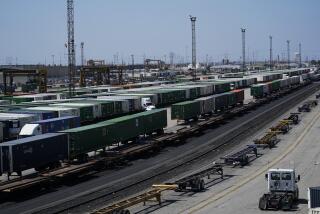Metrolink got a waiver to not post simple safety signs
- Share via
More than a decade ago, Metrolink and other commuter rail services throughout California sought and received permission to bypass a federal requirement to install simple safety signs intended to help avoid accidents like last year’s Chatsworth disaster.
The action was disclosed this week in a technical and financial analysis of high-tech train collision avoidance systems prepared by the staff of the state Public Utilities Commission, which shares some oversight responsibilities for commuter rail systems.
The report concluded that the 25 deaths and 135 injuries caused by the Metrolink catastrophe show the signs should be installed, an action that could be ordered by the commission next year. The placards, which some railroads in other states are using, were to be placed on certain signals and at each end of stations such as Chatsworth.
Known in railroad parlance as “delay in block” warnings, they are designed to remind locomotive engineers of speed restrictions required after they stop at passenger depots located within a series, or “block,” of signals.
Generally, those restrictions require trains leaving the station to stay under 40 mph and be prepared to stop until engineers see a signal indicating it is clear to go faster.
The federal requirements were prompted by deadly, back-to-back 1996 passenger rail accidents in New Jersey and Maryland that were similar to the Chatsworth crash. In both cases, engineers failed to stop at junction signals.
Metrolink and many other railroads argued at the time that they should be granted a waiver of the rule because the signs could be confusing. Federal rail regulators agreed, allowing most commuter train systems to forgo installing the signs.
In a statement Wednesday, a Metrolink spokesperson said the agency “has always been and will continue to be” in compliance with federal rail safety orders, including signage requirements. Federal regulators at that time deemed the agency’s approach to signage to be safe, the agency said.
“Metrolink is constantly evaluating the railroad signal system with our federal and state partners with safety our highest priority,” the statement said.
The signs may not have prevented the Chatsworth crash, PUC regulators acknowledged in their report. But the safety value of such signs clearly outweighs any potential for confusion, they said.
The commission report also notes that the signs were specifically intended to address one of the safety violations that evidently occurred in Chatsworth, when a Metrolink engineer sped away from the station, reaching 54 mph as he approached an apparent red light.
Engineer Robert Sanchez, who died in the crash, also was text messaging on a cellphone in violation of rules. He ran the stop signal just before plowing into a Union Pacific freight train, according to preliminary findings by the National Transportation Safety Board.
(Some witnesses have said the final signal was green as Metrolink 111 approached, although federal investigators say they have found no evidence supporting those claims.)
In its report, the PUC said Metrolink obtained approval to forgo the signs after assuring federal officials the commuter rail service required adherence to the speed and operating restrictions “by all trains, in all [signal] blocks, at all times.”
But Metrolink’s subsequent efforts to make sure engineers actually followed the restrictions appear to have been “less than satisfactory,” the report states.
The PUC analysis concludes that a computerized safety system, known as positive train control, is the most effective means of avoiding passenger rail accidents. Investments in other interim crash prevention technologies should not be required by the commission and priority should be given to deploying positive train control rapidly, the report recommends.
In the meantime, other passenger rail services should consider following Metrolink’s lead by installing video cameras on trains to monitor engineers’ activities, the report states.
More to Read
Sign up for Essential California
The most important California stories and recommendations in your inbox every morning.
You may occasionally receive promotional content from the Los Angeles Times.













